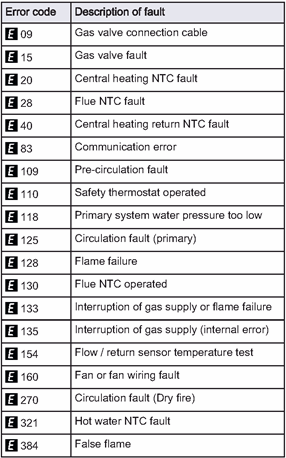Common Boiler Error Codes
Has a boiler error code started flashing on your machine? Go Assist experts are here to help decipher the code. Read below to learn more.
As with most appliances these days, modern boilers routinely feature digital control systems complete with graphic displays (GUIs, if you like your computer to speak) that show useful information and help to make operation as simple and intuitive as possible.
One of the things boiler displays do is show error codes if a fault is detected in the system. This self-diagnostic system is intended to act as an early warning to help speed up repair by providing a guide as to what the problem might be. We should point out, however, that the purpose of the codes is so boiler owners can pass on the information to a registered gas safe engineer - not to attempt repairs themselves.
But hey, we’re all curious and it is natural enough to ask what the codes actually mean, right? Well, the first thing to say is that codes vary from manufacturer to manufacturer, with certain makes - Vaillant and Worcester Bosch, to name but two - utilising their own unique systems.
4 Common Boiler Error Codes
However, a good number of boiler
manufacturers stick to a broadly consistent set of codes. Here are four of the more common examples to look out for on your system.
E20
Error codes and the diagnostic system they represent are based around a series of sensors built into your boiler and central heating system. There are a whole family of temperature sensors used known as NTC thermistors, and a whole family of codes that indicate that the sensor itself doesn’t seem to be working properly. E20 often means the main central heating NTC thermistor is faulty and requires a new component to be fitted.
E110
This tends to mean that the safety thermostat on your boiler has switched on, which in layman’s terms means your system is overheating. This can be more alarming than it sounds - it could be caused by the water pressure dropping below the minimum operational value, usually 0.5 bar. This is often very straightforward to fix, and your engineer may advise you to try bleeding the radiators and/or repressurising the system before attending. The E125 code is closely related, indicating a system circulation error and often requiring the same fixes.
E117-9
A fluctuation in water pressure above or below the normal range does not always lead to the safety thermostat being triggered, and may instead cause an issue with the water pressure switch. You will often see E117 meaning water pressure is too high, E118 meaning water pressure is too low, or E119 to mean water pressure switch error / general water pressure fault.
E133
This usually means that there is some kind of problem with the gas supply and is usually triggered by an inability to ignite a flame. There are a variety of reasons why a flame might not light on a boiler so it is not always guaranteed that it is a supply fault, however, this could be a serious issue (i.e. a gas leak) so it is important to get it checked out as quickly as possible.
Fast reliable boiler repairs
Remember - these codes are guides only, and you are strongly advised not to attempt any kind of repair yourself without at least consulting a qualified gas engineer. Click
here to get a free quote from a local engineer today.

Disclaimer
Any information in this blog is designed to provide general helpful information on the subjects discussed -should not rely on this information. We make no representation as to the accuracy, completeness, suitability, or validity of any such information. The content of this blog may be subject to amendment, without notice, at any time. This information is not designed to be professional advice and any information given in this blog is general and is not tailored to your specific situation. If you have any concerns, you should always seek an appropriately-qualified professional for expert advice. Never disregard professional advice given to you or delay seeking it because of something you have read in this blog. Any actions or omissions taken by you in reliance on the information contained in this blog are at your own risk. We shall have no liability to you or any other person for any liabilities, costs, expenses, damages or losses (including but not limited to any direct, indirect or consequential losses, loss of profit, loss of reputation and all interest, penalties, legal costs, other professional costs and/or expenses) arising out of or in connection with any information contained in this blog.

